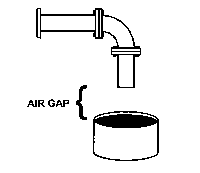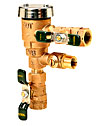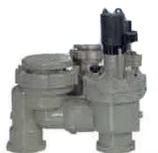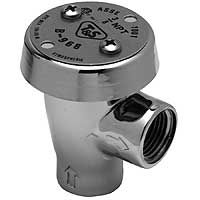|
QUESTION: What is a cross-connection?
ANSWER: A cross-connection is any temporary or permanent connection between a
public water system or consumer's drinking (potable) water system and any
source or system containing non potable water or other substances. An example is
the piping between a public water system or consumer's potable water system and
an auxiliary water system (underground well), cooling system, heating system or irrigation system.
(TOP)
QUESTION: What is backflow?
ANSWER: Backflow is the undesirable reversal of flow of non potable water,
contaminants or other substances through a cross-connection into the piping of a public
water system or consumer's potable water system. There are two types of
backflow... backpressure and backsiphonage.
(TOP)
QUESTION: What is backpressure?
ANSWER: Backpressure is caused by a downstream pressure that
is greater than the upstream or supply pressure in a public water system or
consumer's potable water system. Backpressure can result from an increase in
downstream pressure, a reduction in the potable water supply pressure, or a
combination of both. Increases in downstream pressure can be created by pumps,
temperature increases in boilers or water heaters etc. Reductions in potable water supply
pressure occur whenever the amount of water being used exceeds the amount of
water being supplied, such as during water line flushing, fire fighting, or
breaks in water mains.
(TOP)
QUESTION: What is backsiphonage?
ANSWER: Backsiphonage is caused by a negative pressure (i.e., a vacuum
or partial vacuum) in a public water system or consumer's potable water
system. The effect is similar to drinking water through a straw. Backsiphonage
can occur when there is a stoppage of water supply due to nearby fire fighting,
a break in a water main, a flow of water on a lower floor in a multi floor building, etc.
(TOP)
QUESTION: What is a backflow preventer?
ANSWER: A backflow preventer is a means or mechanism to prevent backflow. The
basic means of preventing backflow is an air gap, which either eliminates a
cross-connection or provides an open gap (physical separation) to prevent backflow. The basic mechanism for
preventing backflow is a mechanical backflow preventer, which provides a
physical barrier to backflow. The principal types of mechanical backflow
preventer are the reduced-pressure principle assembly, the double check valve
assembly, pressure vacuum
breaker assembly and the standard vacuum breaker (like on residential irrigation
systems). A secondary type of
mechanical backflow preventer is the residential dual check valve.
(TOP)
QUESTION: What is an air gap?
ANSWER: An air gap is a vertical, physical separation between the end of a water
supply outlet and the flood-level rim of a receiving vessel. This separation
must be at least twice the diameter of the water supply outlet and never less
than one inch. An air gap is considered the maximum protection available against
backpressure backflow or backsiphonage but is not always practical and can
easily be bypassed. Look at the sinks in your house, do you recognize the air
gap?
(TOP) |
 |
|
QUESTION: What is a reduced principle assembly (RP)?
ANSWER: An RP is a mechanical backflow preventer that consists of two
independently acting, spring-loaded check valves with a mechanically
independent, hydraulically operated, spring-loaded pressure differential relief valve
between the check valves and below the first check valve. It includes shutoff
valves at each end of the assembly and is equipped with test cocks. An RP is
effective against backpressure backflow and backsiphonage. RP's are used to
protect against toxic fluids in water services to industrial plants, hospitals,
morgues, mortuaries, and chemical plans. Other common uses include: irrigation
systems, boiler feed, water lines and other installations requiring
the highest level of mechanical protection. RP's must be installed above
ground and should have a minimum clearance of 12" from bottom of relief valve.
When installing allowances should be made for good access to the device for repairs and testing.
(TOP) |



 |
|
QUESTION: What is a double check valve assembly (DCVA)?
ANSWER: A DCVA is a mechanical backflow preventer that consists of two
independently acting, spring-loaded check valves. It includes shutoff valves at
each end of the assembly and is equipped with test cocks. A DC is effective
against backpressure backflow and backsiphonage but should be used to isolate
only non health hazards. Double check assemblies are typically used
to prevent backflow of pollutants that are objectionable but not toxic.
These can be installed under continuous pressure service and may be subjected
to backpressure. Double checks can be used on sprinkler irrigation
systems without chemical additives (in some jurisdictions a DC is not allowed
on sprinkling systems), fire protection without chemical additives, protection
of industrial plants, industrial in-plant plumbing systems and other systems
requiring protection. Installations should be made to allow for ease of repair and testing.
Check with your local jurisdiction regarding installation of a double check device.
Some areas limit or restrict double check installations and require the use
of an RP.
(TOP) |



 |
|
QUESTION: What is a pressure vacuum breaker assembly (PVB
& SVB)?
ANSWER: A PVB is a mechanical backflow preventer that consists of an
independently acting, spring-loaded check valve and an independently acting,
spring-loaded, air inlet valve on the discharge side of the check valve. It
includes shutoff valves at each end of the assembly and is equipped with test
cocks. A PVB is only effective
against backsiphonage and can be used to protect against health hazard and
non-health hazard backsiphonage conditions in industrial
plants, cooling towers, laboratories, laundries, swimming pools and lawn
sprinkler systems. These must be installed 12" above the highest
piping and outlets downstream of the assembly to preclude backpressure.
When installed there should be clearance for ease of repair and testing.
The newest of the PVB devices is the Anti-Siphon, Spill-Resistant, Vacuum Breaker (SVB).
Like the PVB, they prevent the reverse flow
of polluted water from entering into the potable water supply due to
backsiphonage on point-of-use applications with the exception they were designed for
indoor point of use applications. These devices are designed to prevent spillage at start up when
supply pressure is applied to it.
(TOP) |


 |
|
QUESTION: What is an atmospheric vacuum breaker assembly (AVB)?
ANSWER: An AVB can be used to
protect against backsiphonage where it is not subjected to backpressures.
The most commonly used atmospheric anti-siphon vacuum breakers incorporate
an atmospheric vent in combination with a check valve. Its operation
depends on a supply of potable water to seal off the atmospheric vent,
admitting the water to downstream equipment. If a negative pressure
develops in the supply line, the loss of pressure permits the check
valve to drop sealing the orifice while at the same time the vent opens
admitting air to the system to break the vacuum.
It must be installed on the discharge side of the last shut-off valve and must
be installed 6" above highest outlet. Typical installations include
hose bibbs, chemical vats, X-ray tanks, turf irrigation systems, and laboratory
sinks.
(TOP) |


 |
QUESTION: What is a residential dual check valve (RDC)?
ANSWER: A RDC is similar to a DC in that it is a mechanical backflow preventer
consisting of two independently acting, spring-loaded check valves. However, it
usually does not include shutoff valves, mar or may not be equipped with test
cocks or ports, and is generally less reliable than a DC. A RDC is effective
against backpressure backflow and backsiphonage but should be used to isolate
only non-health hazards and is intended for use only in water service connections
to single-family homes.
(TOP)
QUESTION: What is the new "Lead Free Law" regarding plumbing in California? (Assembly Bill AB 1953)
ANSWER: California Assembly Bill 1953 (AB1953) was signed into law September 30th, 2006
by State Governor Arnold Schwarzenegger. The intent of the bill, which takes effect January 1, 2010, was to reduce the amount of lead in specific plumbing fixtures from its current regulated
amount of no more than 8%, to a new standard not to exceed 0.25%. Specific language in the bill states... "No person shall introduce into commerce, for use in California, any pipe, pipe or plumbing fitting,
or fixture intended to convey or dispense water for human consumption through drinking water or cooking that is not lead free. This includes kitchen faucets, bathroom faucets, and any other end-use devices
intended to convey or dispense water for human consumption through drinking or cooking." (Read the bill in PDF format)
Some states are specifying no-lead materials that contain no more that 0.10% lead.
(TOP)
QUESTION: Why do backflow preventers have to be tested periodically?
ANSWER: Mechanical backflow preventers have internal seals, springs, and moving
parts that are subject to fouling, wear, or fatigue. Also, mechanical backflow
preventers and air gaps can be bypassed. Therefore, all backflow preventers have
to be tested periodically to ensure that they are functioning properly. A visual
check of air gaps is sufficient, but mechanical backflow preventers have to be
tested with properly calibrated gauge equipment.
(TOP)
QUESTION: What are the regulations, requirements and procedures in testing a Backflow Device?
ANSWER:
This information may be found in many publications such as; California State Water Resources Board, The Universal Plumbing Code
the USC Foundation for Cross-Connection Control and Hydraulic Research,
along with state and local administrative authorities, utilities and water purveyors.
The latest testing procedures can be purchased in the Tenth Edition of the USC Manual of Cross-Connection Control.
(TOP)
QUESTION: Why do water suppliers need to control cross-connections and protect their public water systems against backflow?
ANSWER: Backflow into a public water system can pollute or contaminate the water
in that system (i.e., backflow into a public water system can make the water in
that system unusable or unsafe to drink), and each water supplier has a
responsibility to provide water that is usable and safe to drink under all
foreseeable circumstances. Furthermore, consumers generally have absolute faith
that water delivered to them through a public water system is always safe to
drink. For these reasons, each water supplier must take reasonable precautions
to protect its public water system against backflow.
(TOP)
QUESTION: What should water suppliers do to control cross-connections and protect their public water systems against backflow?
ANSWER: Water suppliers usually do not have the authority or capability to
repeatedly inspect every consumer's premises for cross-connections and backflow
protection. Alternatively, each water supplier should ensure that a proper
backflow preventer is installed and maintained at the water service connection
to each system or premises that poses a significant hazard to the public water
system. Generally, this would include the water service connection to each
dedicated fire protection system or irrigation piping system and the water
service connection to each of the following types of premises: (I ) premises
with an auxiliary or reclaimed water system: (2) industrial, medical,
laboratory, marine or other facilities where objectionable substances are
handled in a way that could cause pollution or contamination of the public water
system; (3) premises exempt from the State Plumbing Code and premises where an
internal backflow preventer required under the State Plumbing Code is not
properly installed or maintained; (4) classified or restricted facilities; and
(S) tall buildings. Each water supplier should also ensure that a proper
backflow preventer is installed and maintained at each water loading station
owned or operated by the water supplier.
(TOP)
QUESTION: Where can I get more information about cross-connection control?
ANSWER:
One excellent reference is the
University of Southern California's Foundation for Cross-Connection Control and Hydraulic
Research; University of Southern California; KAP-200 University Park MC-2531;
Los Angeles, California 90089-2531; 213/740-2032;
http://www.usc.edu/dept/fccchr.
Another excellent reference is the American Water Works Association's (AWWA's) Manual M14, Recommended Practice for
Backflow Prevention and Cross-Connection Control, which is available from the
AWWA Bookstore; 6666 West Quincy Avenue; Denver, Colorado 80235; 800/926-7337;
http://www.awwa.org/ .
(TOP)
QUESTION: What is reclaimed water or recycled water?
ANSWER: Reclaimed water or recycled water, is former wastewater
(sewage) that is treated to remove solids and impurities, and used in sustainable landscaping irrigation, to recharge groundwater aquifers, to meet
commercial and industrial water needs, and for drinking. The purpose of these processes is sustainability and water conservation, rather than discharging
the treated water to surface waters such as rivers and oceans.
[Wikipedia]
(TOP)
|
